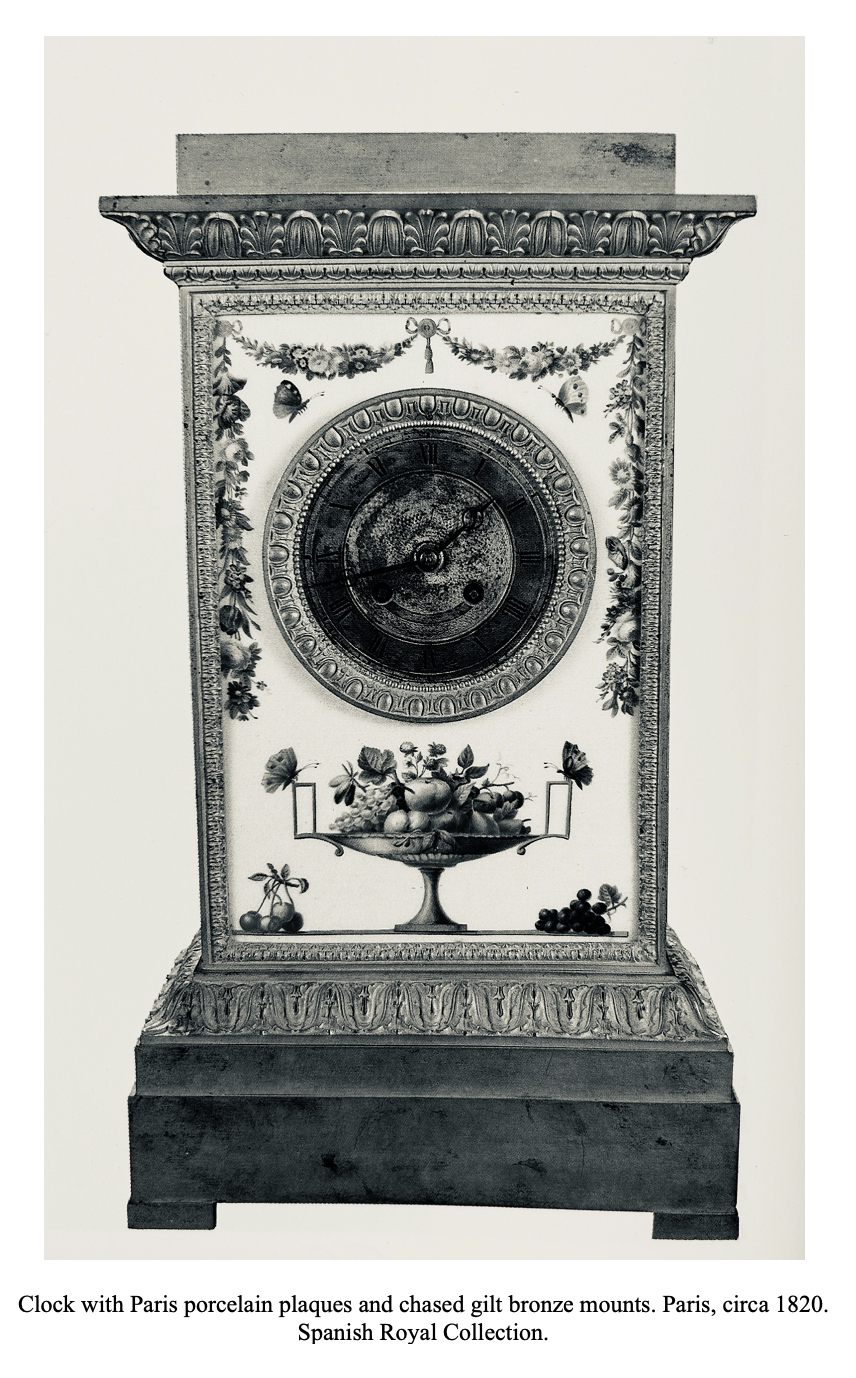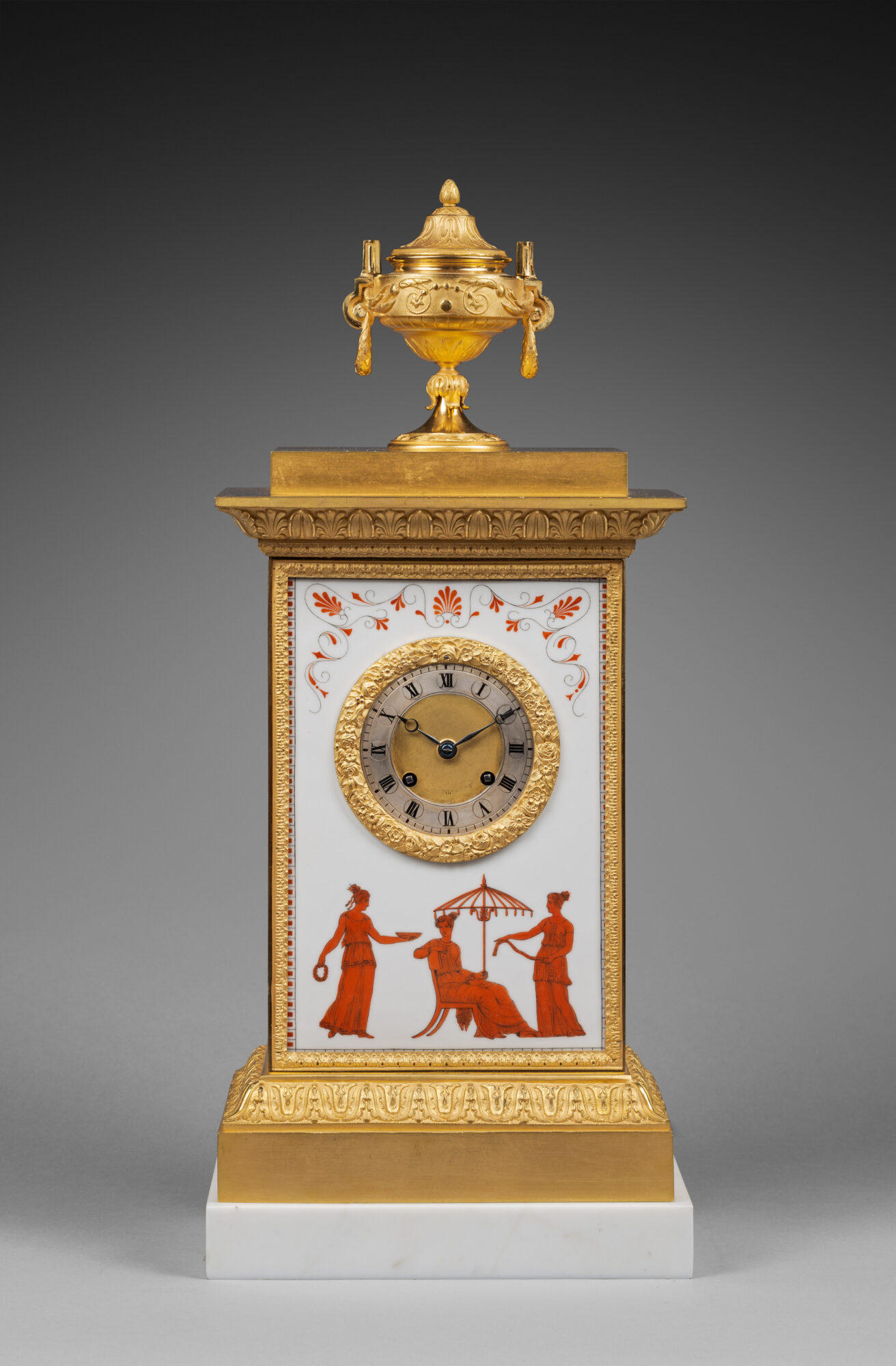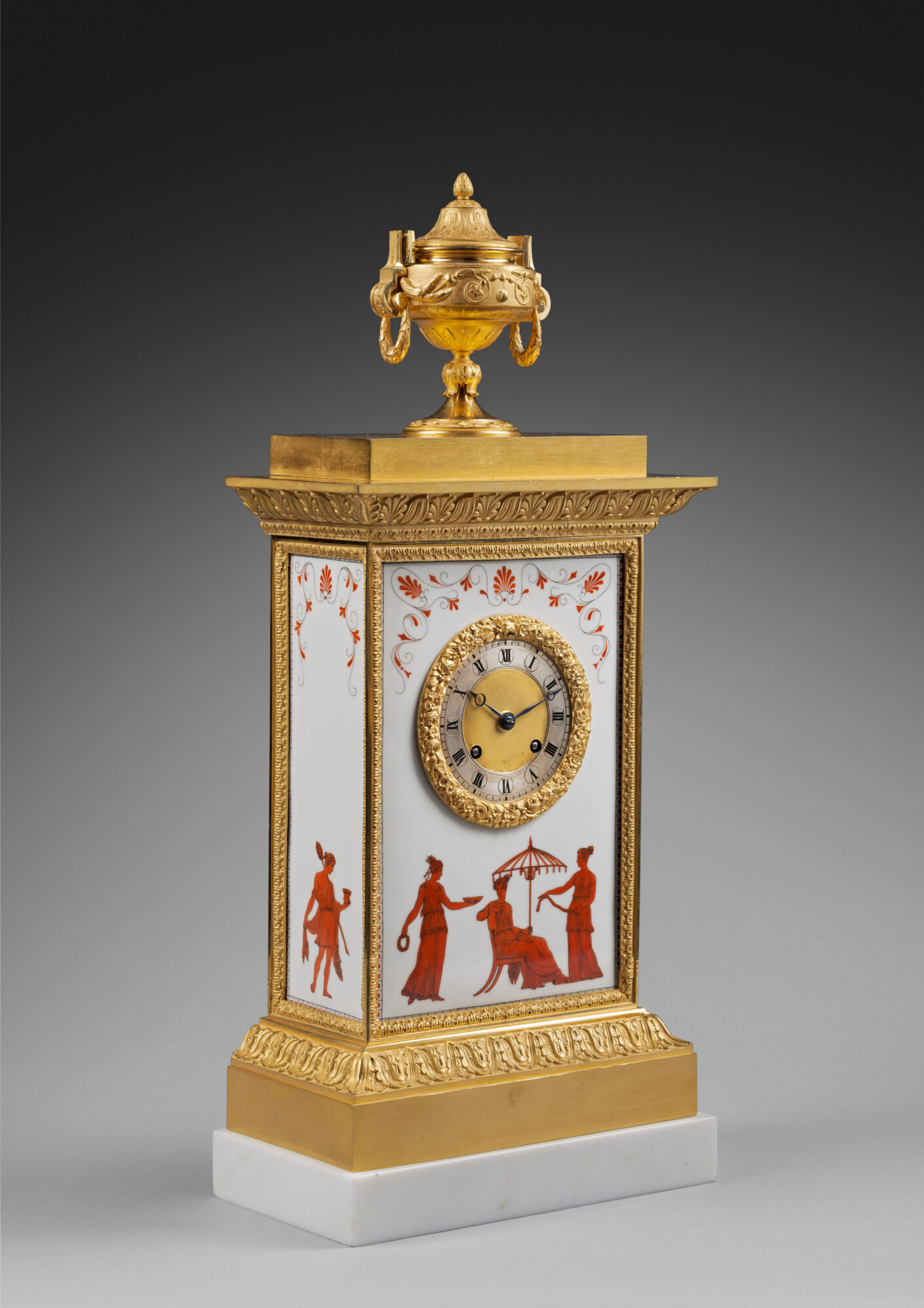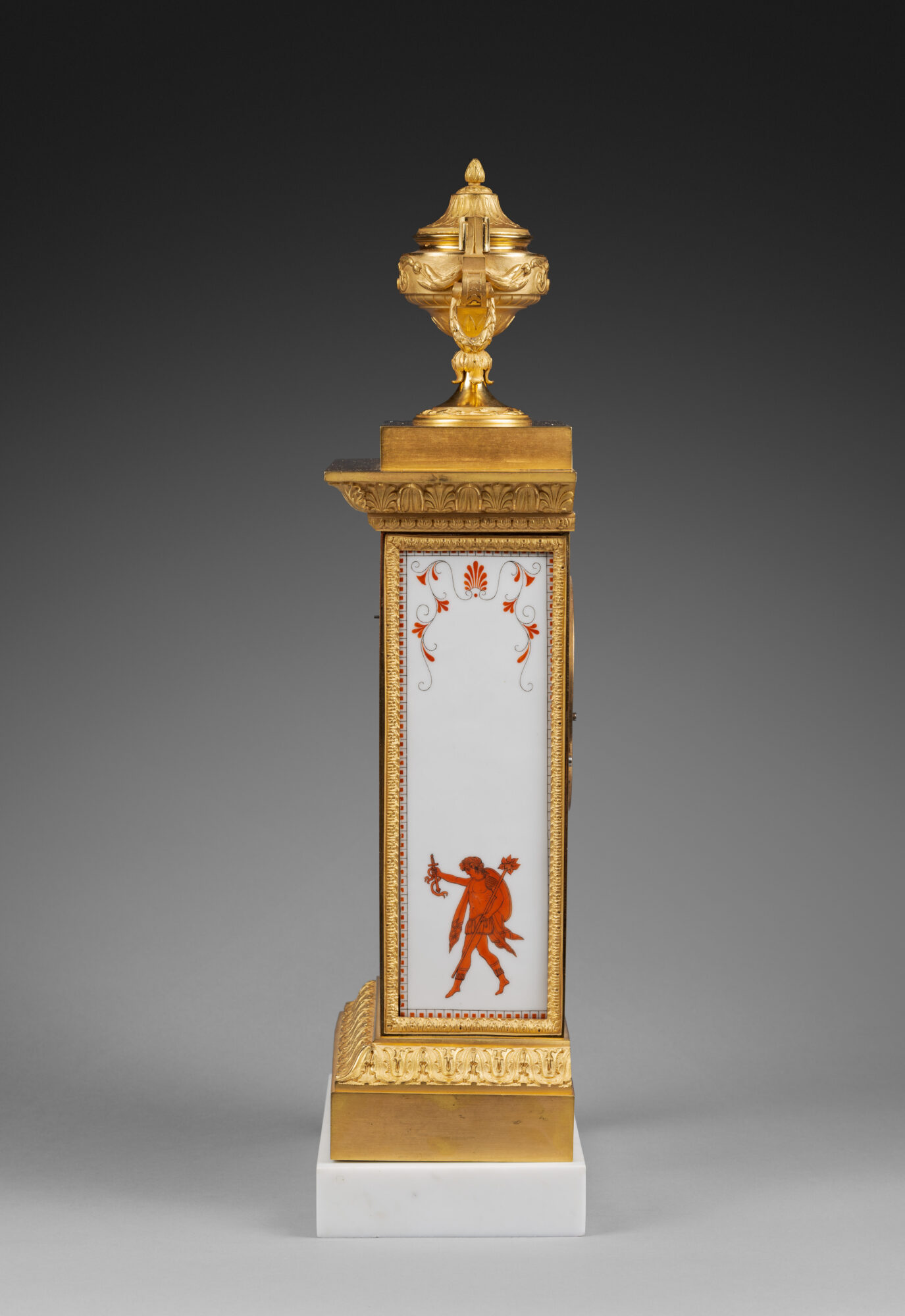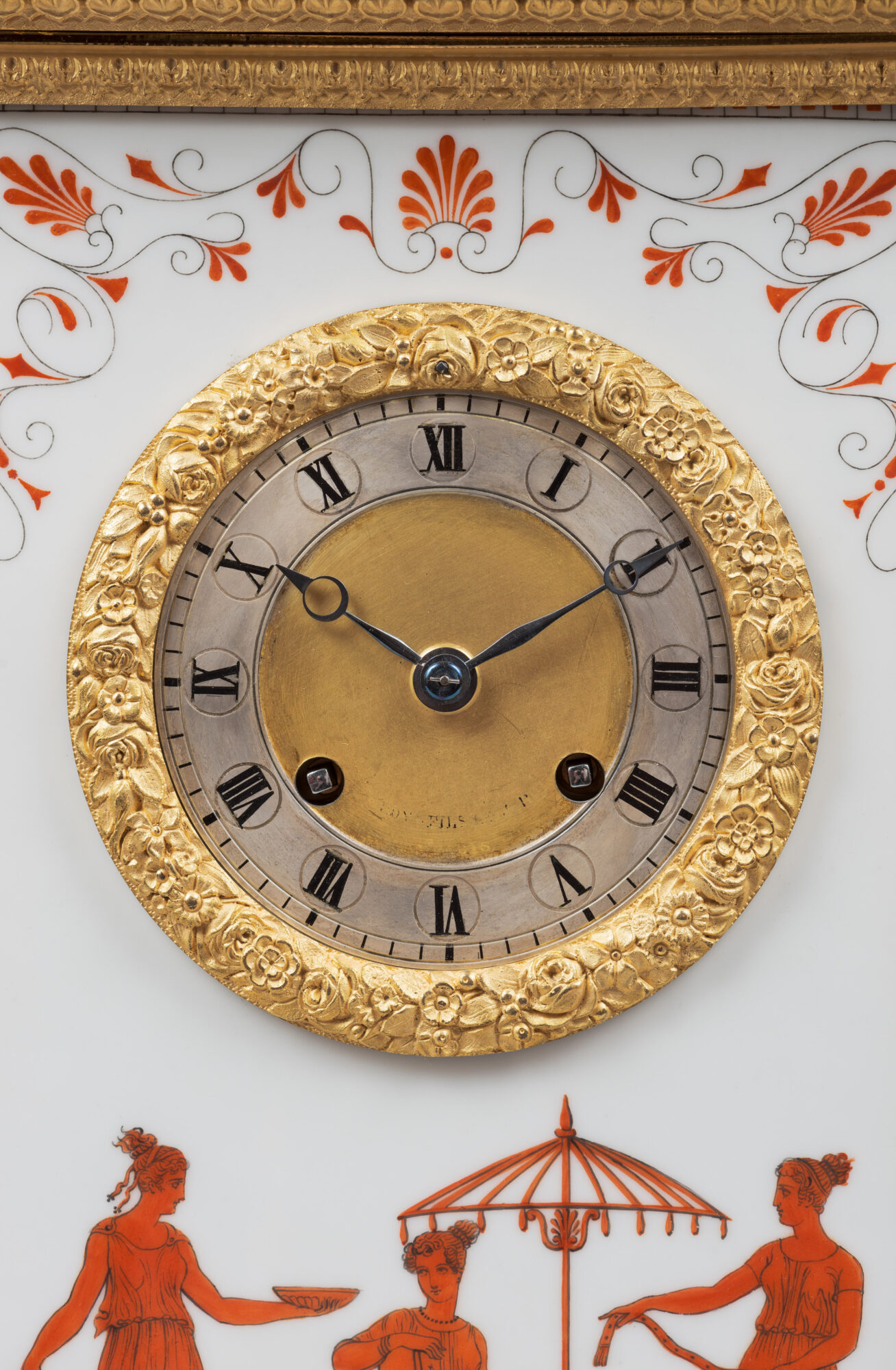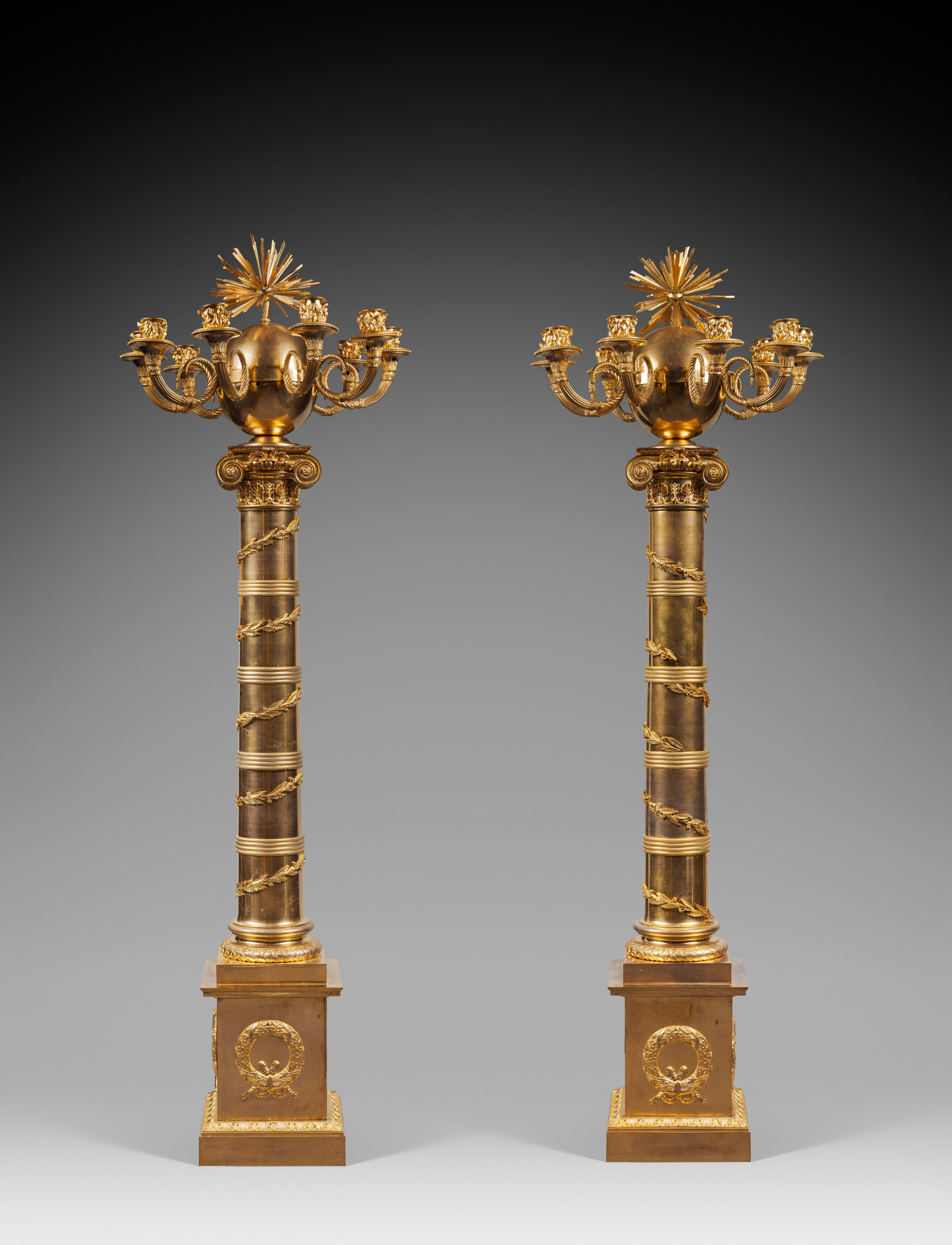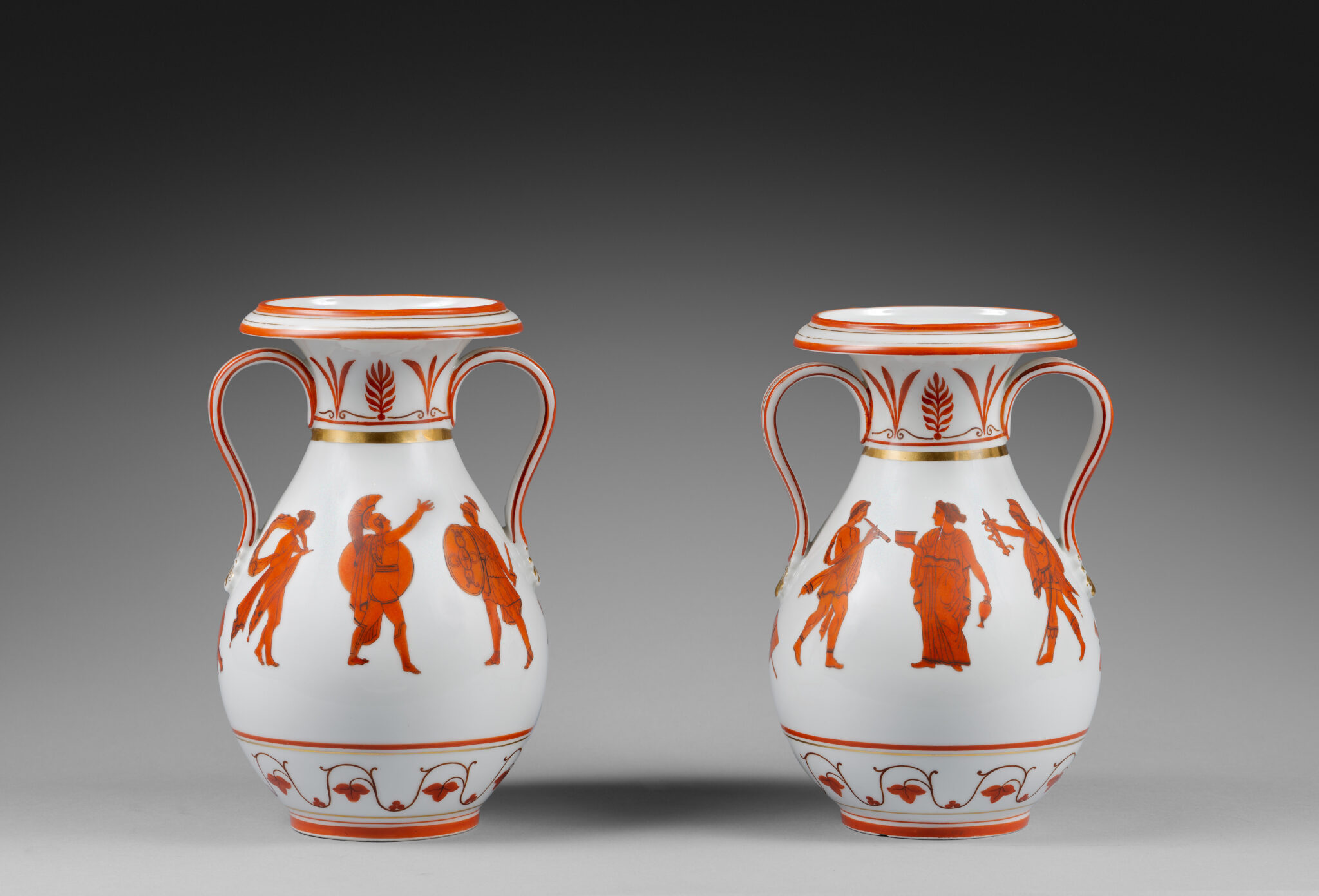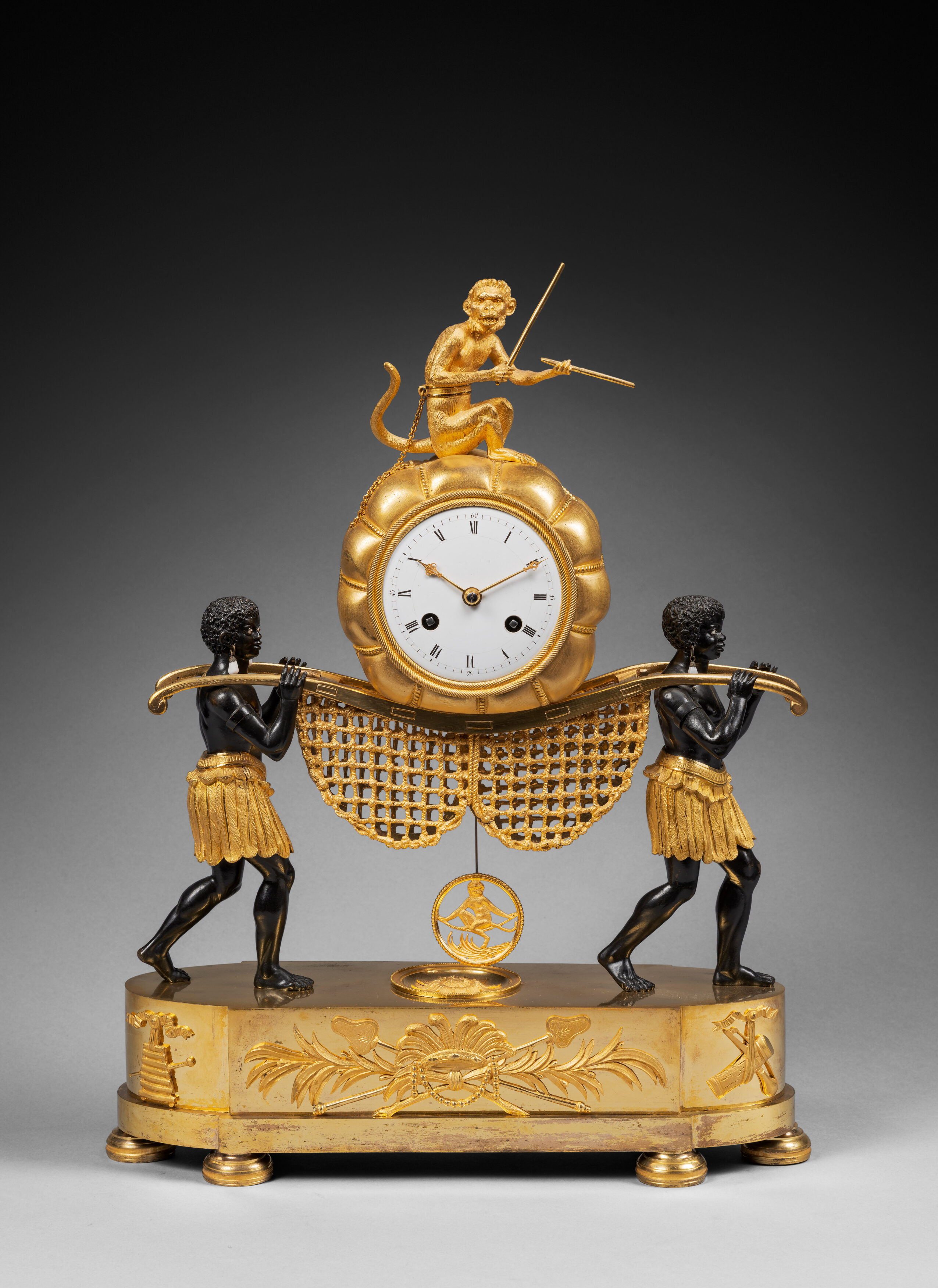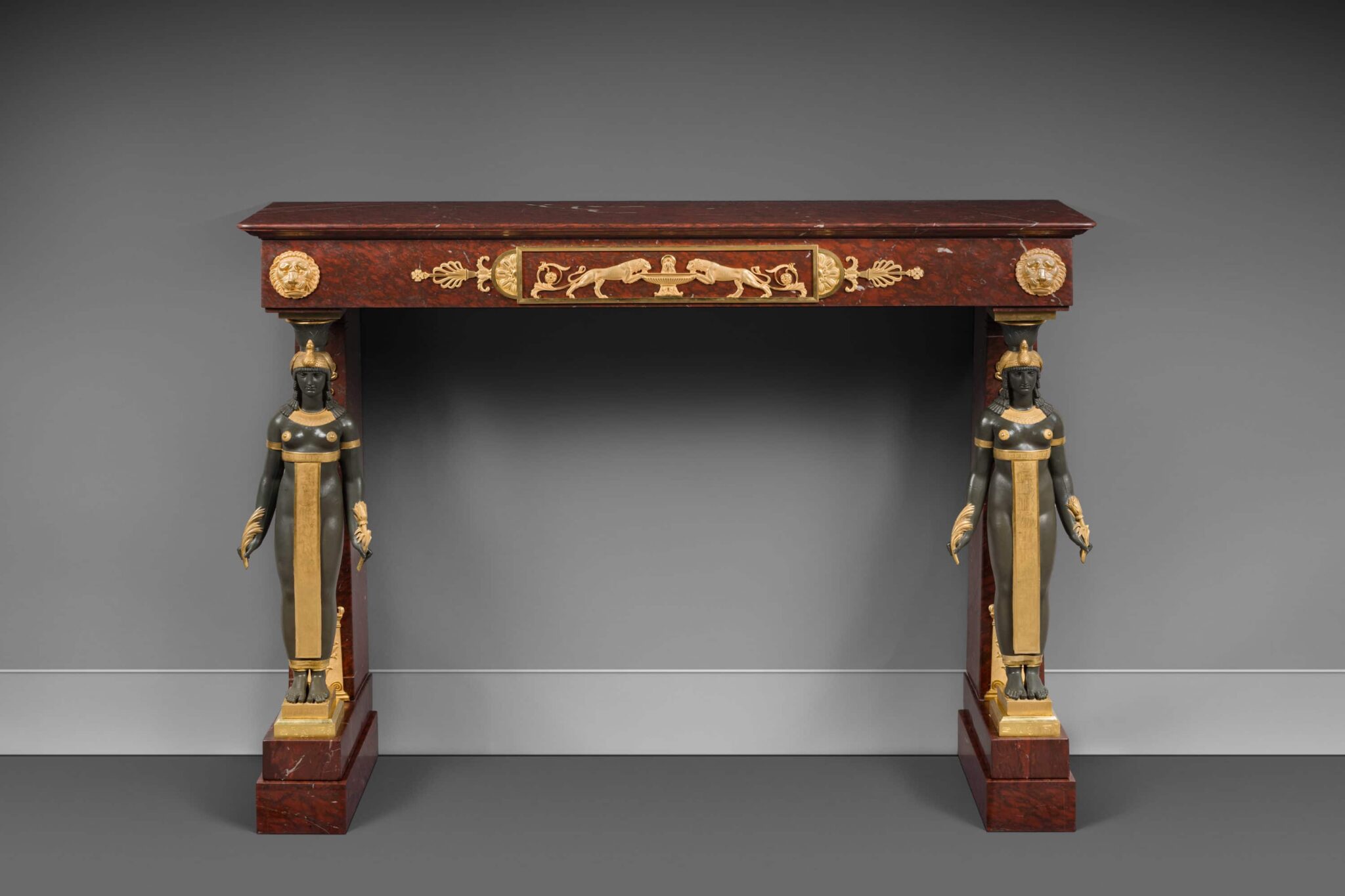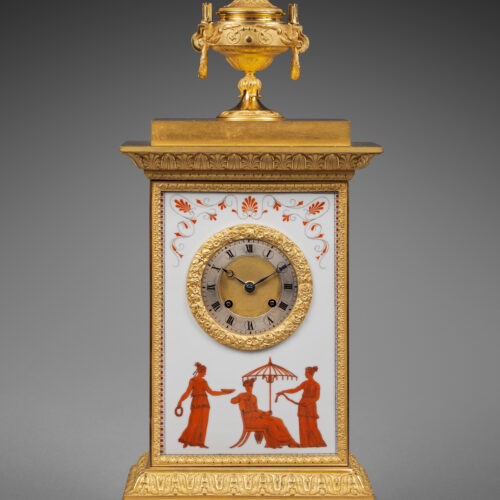A Rare Classical-Style Clock made of Paris Porcelain and Gilt Bronze with Matte Finishing
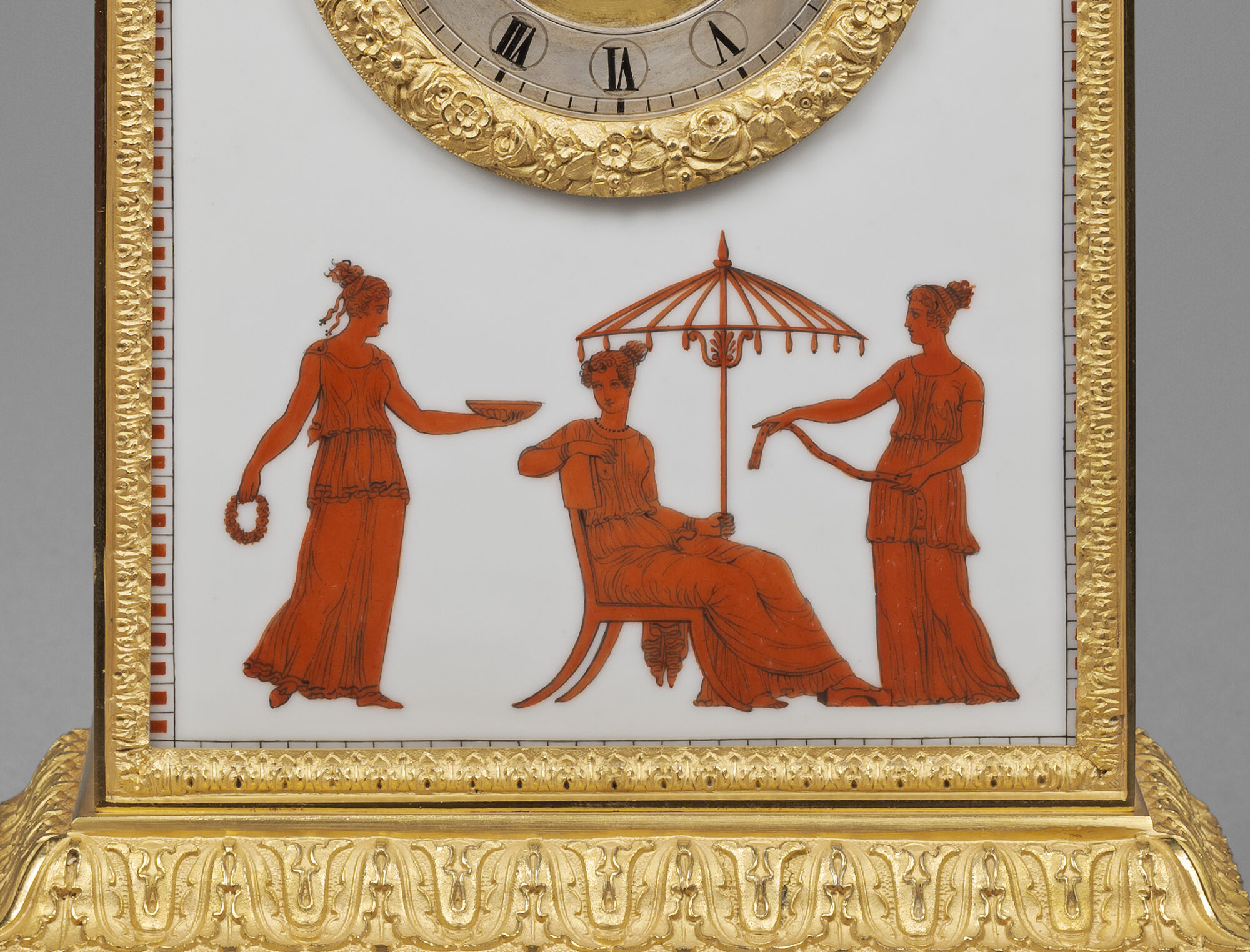
(Le) Roy & Fils Horlogers du Roi
The Porcelain Case Attributed to the Dagoty Manufactory
Paris, Restauration period (Charles X), circa 1828
The silvered and gilt bronze dial, signed “(Le) Roy & Fils Hers du Roi”, indicates the Roman numeral hours and outermost minute graduations by means of two blued steel Breguet hands. The hour and half-hour striking movement is housed in a rectangular Neoclassical case with Paris porcelain plaques and finely chased matte gilt bronze mounts. We can see the signature « Leroy & Fils Hers du Roi à Paris » engraved on the movement (meaning “Leroy & Sons Clockmakers of the King in Paris”). The bezel is adorned with flowers and leaves; the clock is surmounted by an urn with applied Greek-style handles and a cover with a pinecone finial that stands on a quadrangular entablature adorned with a frieze of palmettes alternating with stylized leaves. The case features molded leaf-decorated bands, which secure porcelain plaques adorned with orange and brown arabesque and palmette motifs against a white ground, as well as figures. There are two male figures on the sides, one holding a thyrsus and the other a sword, and on the façade there are three women, one of whom is sitting on a klismos chair and holding a parasol. The quadrangular base is adorned with molding decorated with a frieze of leaves; it stands on a white Carrara marble plinth.
A pair of two vases that go perfectly with this clock can be viewed here. They originally came as a set with the clock, but can be purchased separately as well.
Discover our entire collection of rare antique clocks online or at the gallery.
The use of porcelain in Parisian horology dates from the first half of the 18th century. At the time, porcelain was employed for the figures, statuettes and flowers that adorned clocks. Techniques evolved during the Empire period, and in the early decades of the 19th century clocks – most of which were rectangular in shape – began to be decorated with porcelain plaques. Among the known models made in this style, one example, produced in 1821 and adorned with Sèvres porcelain plaques with a blue or purple ground, featuring a depiction of Cupid swinging on his bow, is now in the Musée du Louvre in Paris (illustrated in L. de Gröer, Les arts décoratifs de 1790 à 1850, Office du Livre, Fribourg, 1985, p. 291, fig. 557). A second example, also in Sèvres porcelain, was made in 1838 and delivered to the Château de Saint-Cloud the following year (see the exhibition catalogue Un âge d’or des arts décoratifs 1814-1848, Galeries nationales du Grand Palais, Paris, 1991, p. 274, catalogue n° 143). A third clock, with a gilt bronze case identical to that of the present clock, was in the Royal Spanish Collection (illustrated in J. Ramon Colon de Carvajal, Catalogo de relojes del Patrimonio nacional, Madrid, 1987, p. 402, catalogue n° 398). One further clock that is nearly identical to the present one (though with some variation in its decoration and design), with a movement by Leroy, may be seen in P. Kjellberg, Encyclopédie de la pendule française du Moyen Age au XXe siècle, Les éditions de l’Amateur, Paris, 1997, p. 371. That clock, like the present one, may be attributed to the Maison Dagoty, one of the best-known Parisian porcelain factories of the period. Dagoty specialized in decors featuring figures inspired by ancient Greek Attic vases; a pair of comparable vases is illustrated in R. de Plinval de Guillebon, Faïence et porcelaine de Paris XVIIIe-XIXe siècles, Editions Faton, Dijon, 1995, p. 343.
Founded in 1798 by the two Dagoty brothers, this Parisian porcelain factory is considered one of the most successful of the early 19th century. The two brothers, grandsons of the painter Jacques Dagoty and sons of the engraver Jean-Baptiste Gauthier Dagoty, took over a failing company, the Bougon factory in the rue de Chevreuse. One of the brothers, Etienne, died in 1800; the remaining brother Pierre-Louis (1771-1840) ran the factory alone as of 1804. He successfully developed the business and during the Empire period the firm employed 100 workers.
After the fall of the Emperor, Dagoty went into partnership with the Honoré père et fils manufactory, which was also very prosperous, using the name “Dagoty et Honoré” until 1820. Afterwards Edouard Honoré took over the company in Paris. Throughout the factory’s existence, it distinguished itself for to the quality and originality of its creations. The maison received orders from the Imperial Garde-Meuble as of 1804. It took part in the Exposition des produits de l’Industrie in 1819, where it received a silver medal for “Wedgwood type” bas-reliefs, a tripod and a model of the Fontaine des Innocents.
Bazile-Charles Le Roy (1765 - 1839)
The firm “Le Roy & Fils” was created in 1828 by Bazile-Charles Le Roy (1765-1839) and his son Charles-Louis Le Roy. They signed as “Leroy & Fils Horlogers du Roi” during the Restoration, being clockmakers of the King Charles X. Upon the death of his father Charles-Louis took over the firm, which was very successful, soon becoming suppliers to the King Louis-Philippe and the Duke d’Orléans (son and heir of Louis-Philippe). In 1845, Charles-Louis sold the company to an employee, Casimir Desfontaines, who continued to run Le Roy & Fils, in 1856 opening a shop at 211-Regent Street in London and taking part in most of the important international exhibitions, winning many prize medals. Named Watchmaker to the Queen of England and to the Emperor of Brazil, he won many honours and in 1883 left the firm to his son Georges Desfontaines.

